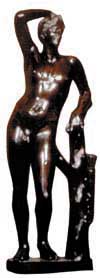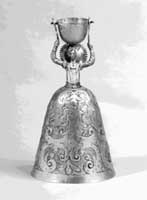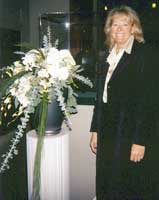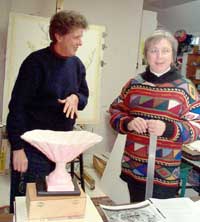 Look quick! Here comes the weekend when Baltimore's famous art museum turns into a flower gallery Look quick! Here comes the weekend when Baltimore's famous art museum turns into a flower gallery
By Sandra Martin
Giant electrical plugs. Mad dashes of color. Things suspended in midair. Heroic guys intertwined with fatal snakes. Art sometimes makes you wonder. If you're one to scratch your head and worry what it all means, here come a couple dozen new itches.
Just what might those brilliant red and orange and blue posies have do to with a 14th century icon picturing the annunciation and crucifixion? It must mean something, for here they are, pedal to predealla as it were, labeled as partners. But one's a cascade of flowers arranged by the Cliff Dwellers Garden Club and the other's a two-sided panel painted some 700 years ago on a well-seasoned board with tempera (pigment mixed with egg yolk) and burnished with gold foil to inspire reflection on the signal events of the life of Jesus Christ.
If unpuzzling relationships like that make you itch with interpretive delight, then Baltimore's Walters Art Museum is the place for you.
But you'll have to act quickly because these puzzling "art blooms" last just one weekend.
More Than Pretty Flowers
The Walters Art Museum is ranked as "piece-for piece, the best art museum in the entire United States" by Thomas Hoving, author of Art for Dummies. But Hoving is no dummy: He's the former director of New York's Metropolitan Museum of Art.
 Among the treasures held by this Baltimore city art museum are a 15th century limestone Madonna and child Hoving calls "lyrical." And a 19th century iris corsage by the famous American jeweler Tiffany, studded with precious stones, including 137 Montana sapphires. Among the treasures held by this Baltimore city art museum are a 15th century limestone Madonna and child Hoving calls "lyrical." And a 19th century iris corsage by the famous American jeweler Tiffany, studded with precious stones, including 137 Montana sapphires.
Those are just two gems in a museum that has evolved from the personal collection of an acquisitive father and son into a world-class treasury of art spanning 55 centuries.
Not that the Walters' personal collection was anything to sniff at. Father William began the collection, focusing on Asian and Academic French art, but branching out to include diverse wonders such as the iris corsage he bought from Tiffany in 1900. Building on his father's collection, son Henry spanned the ages, from ancient Egypt to the beginning of the 20th century. In 1931, he bequeathed a personal collection of some 22,000 works of art - with a gallery to hold them - to the city of Baltimore.
In 1974, the museum added a second building, named for its location the Center Street Building, to hold its ever-growing collection. That building has been closed for renovation since 1998. When it reopens in October, about 17,000 works will be on view - with many more in storage. Until then, a large percent of the Walters' art - including its ancient and medieval art and 19th century paintings - remains in storage.
Which means that to get a booking in the Walters these days, you've usually got to be somebody with as big a name as Edouard Manet, 55 of whose Still-Life Paintings are gathered at the museum for a once-in-our-lifetimes exhibit through April 22.
So what's a bunch of flowers doing in a place like this?
Why Art Blooms 
photo courtesy of Tessa Echols
Floral designer Tessa Echols interpreted a German medieval helmet for the Charles County Garden Club’s Art Bloom entry last year.
For one thing, the season. As February yields to March, who doesn't want to give spring a push?
For another, the money. In five years, some $750,000 has come to the Walters from its Women's Committee, which sponsors Art Blooms as its only fund-raising project. As a fund-raiser, matching art and flowers has proved so popular that by 1997, 18 museums regularly hosted such events, according to Victoria Jane Ream in her book Art in Bloom.
For a third, the comparison is an eye-opener.
"It gives you a different eye. You look not only at the flowers but at the masterpiece," says Alicia Haberman, cochair of this year's Art Blooms for the Walters' Women's Committee.
Indeed it does put your eye to work, which accounts for all the head-scratching and eye-squinting you'll see if you visit the Walters the first weekend in March.
Make the trip, and you'll be scratching and puzzling yourself, as I was last year when I chanced into the Walters during Art Blooms' short run.
What, I said to myself, does this stand of gladiola and modernistic twirl of black pipe have do with an 18th century demi-god preserved in self-absorbed allure for the ages?
Clearly, there's something between them. Color builds one bridge between flowers and art, for the vase holding this spare arrangement is gleaming bronze like the statue. But the likeness has more to do with line. The shining bronze statue, though solid as youth, is more about sweep than mass. He is sinuous and curvaceous, as is the shining, ascending spiral orbiting around the floral arrangement. The gladiolus stalk? It echoes Apollino's uprightness, fresh and unblemished.
Is that anything of what that Lutherville Garden Club floral designer had in mind?
Trying to figure out just what are the bonds that unite two such disparate artifacts, my eyes track as if I were watching a tennis match. It's true. I look harder - and maybe deeper - at a statue than I ever have in life.
The fascination of the puzzle also made me vow to find out first-hand in 2001, when Art Blooms returns for its 12th year to the Walters.
Pieces of the Puzzle
Each year, of course, is a whole new ball game. Each year's home team is made up of new players - that might range from an Egyptian mummy to a queen's jewels.
On the Walters' side, picks are made by a team that includes Susan Wallace, the coordinator of special exhibits.
"We choose works that would lend themselves to floral interpretation," Wallace told me. "Often that's actual flowers in the works: a wreath around a head or a pastoral scene. Other times, it's just something more challenging that the garden club can try to figure out to capture the spirit of the piece."
The team may be giggling in glee as they make their selections, Wallace admits, but never "maliciously."
Location is also part of the selection, for chosen art has to be so situated that a big bouquet on a pedestal will not impede the flow of traffic or endanger works or people.
This year's 25 art works span only five centuries, from the 15th to the 20th, for many of the Walters' older works are in storage. Among the chosen are statues, porcelains, paintings and metal works. The figural subjects range from Mary with the infant Jesus to Greek gods to a Roman emperor to a French aristocrat and actress to women wrestlers to the dead Christ. Objects range from a snuff box to a fire screen to a wedding goblet to vases, jewelry and trays to a treasure cabinet.
About two on this year's list you'll soon know more: A "Marriage Cup in the Form of a Woman" made in the mid-17th century by German silversmith Tobias Volkhamer. And a 1776 French porcelain tray painted with a Chinese scene.
Matching Pieces
photo by Sandra Martin
Leslie Baldwin, left, and Pat McHold consider containers for this year’s Four Rivers Garden Club Art Bloom.
Interpreting old masters whose craft has stood the test of time are champion floral arrangers from 25 regional garden clubs. The clubs hail from Pennsylvania and Delaware as well as Baltimore and many of Maryland's counties. Veteran Chesapeake area clubs, returning year after year, include the Charles County Garden Club and, from Annapolis, two venerable clubs: the 77-year-old Four Rivers Garden Club and the 76-year-old Severn River Garden Club.
Twenty-five is the maximum the Walters has room for in its current reduced state. The Women's Committee sends out some 125 announcement letters, so clubs must act fast to secure their place. Then, early in January, the year's roster of clubs gathers at the Walters for assignments.
"The designers go up to the Walters first for a meeting, because there are lots of rules they have to follow," said Kathryn Allan, president of Four Rivers Garden Club. Bringing flowers into an art museum is such tricky business that the Walters' director of conservation draws up a list of dos and don'ts. For one, free-standing water is forbidden which, as you can imagine, sets up some hurdles for flower arrangers.
This year's luck of the draw awarded the "Marriage Cup in the Form of a Woman" to the Charles County Garden Club. The gilt silver cup is only six and five-sixteenths inches high but, said that club's designer, Paula Winkler, "her impact in real life was stunning."
Winkler called herself "one of the lucky ones. I got a black and white picture of her, but some people got only photocopies." She could have taken color photos, as others did. Instead, she took "copious notes and measurements" with the tape measure she carries "everywhere."
Annapolis' Four Rivers Garden Club was matched with a Sèvres porcelain tray. It, too, is small enough that Four Rivers' arrangers Pat McHold and Leslie Baldwin think of it as a dish.
"Oh " said McHold, on first seeing her luck of the draw. And then, immediately, off she galloped on possibilities.
A Wedding Cup
In Charles County, Paula Winkler is approaching her wedding cup with studious delight - and a smidgen of trepidation. For in the lofty halls of the Walters, she'll be making her debut as a floral designer.
"I'm a horticulturist, a grower of roses and lavender and herbs," says Winkler, who pursues her "passion for flowers" with full-time dedication after retiring early from the federal government. Now she's branching out. After two and a half years study, she's just passed her final exam to qualify as a flower show judge. That training - provided through the international federation that includes her garden club and two dozen others in Chesapeake Country - Winkler says, "is what's given me confidence in my design work."
Guiding Winkler in her first big design commission is Tessa Echols, a La Plata professional floral designer who's designed Art Blooms for the Charles County Club the past two years, winning them enduring acclaim for her interpretation last year of a German helmet forged about 1490.
"It was absolutely stunning. Everybody talks about it," said Winkler.
So Winkler has a reputation to live up to as she studies her assignment and imagines how to interpret a small, silver cup in flowers. Along the way, the designer has fallen in love with her subject. "She is so beautiful," said Winkler, "so small and dainty and bell-shaped, and she just gleams."
Talking to Winkler, I was about to satisfy my own year-old itch of curiosity. What, I asked, are you going to do?
"Wedding flowers," she said. "I'm going to emulate a wedding bouquet. Her arms are up holding a wedding cup, so I want to do something with upward motion but with a hint of something a bride would carry."
Ahh-ha.
Winkler has been influenced not only by the subject of her subject but also by its setting. "Red was discounted" because the background wall of the Treasury Room is "a dusty medium mauve."
So she says she's chosen "modern flowers as well as those that, hopefully, would have been around in the 17th century: lavender with roses and tulips in hues of white."
Lavender and roses are not only Winkler's own garden favorites; they also speak the right words in the language of flowers, where lavender, for example, represents devotion. With them she'll mingle "some sort of greenery," perhaps ivy for wedded love.
Just as much thought has gone into the container, for which Winkler has been searching since January, finally finding "the most wo nderful two pieces to mimic her shape." nderful two pieces to mimic her shape."
As I write, two weeks before Art Blooms opens, Winkler is making her "prearrangement." When she's done, she'll photograph it so she can study it in another medium to discover flaws: "a hole or line off."
How many flowers it will take to complete her interpretations, which will rise to "less than 18 inches, including container," she doesn't know. Still, she'll "buy by the dozens" because, she explained, "I'm real particular. A bunch may have only three usable flowers." Her Charles County Garden Club has budgeted $100 for its art bloom.
On the morning of February 28, Winkler will get her flowers and "condition" them by "submerging them up to their necks in big tall buckets in the basement overnight." That way, they'll have absorbed enough water to tolerate a display lifetime in an oasis, or flower-holding sponge, which, Winkler said, "roses and tulips can't stand." She's got a few other tricks up her sleeve to make them behave on the drive to and 48 hours in the Walters.
Where wedding cup and flowers will be waiting for you. Look for Charles County Garden Club's Art Bloom in the Walters' Treasury, to the left of the shared case where lives the delicate wedding cup it interprets.
A Sèvres Tray
Less than two weeks to the big show, flowers are the last things on the minds of Four Rivers Garden Club designers Pat McHold and Leslie Baldwin. They're thinking location, stacking up every container in the house against the space where their art will bloom: the Walters' Sèvres Porcelains Gallery.
Container number three they label nice but probably too small for the room. Though, says Baldwin, yardstick in one hand as she sketches in air a floral approximation rising from the makeshift three-foot-tall pedestal she has erected from art books: "We could do something that high and it could work."
Wide-mouthed container number two McHold labels "the ugliest thing I've ever seen." But it, too, has possibilities. It's pink, and that's one of the theme colors of the imaginary Chinese setting painted on the tray made by a French porcelain artist for the famous "China" house in 1776.
Taller container number one, a brass urn, might make an encore performance at the Walters, where last year it helped Four Rivers interpret an Islamic ewer. But first the designers would snip off its handles and wrap it with borders of bamboo, to evoke the vase depicted on the Sèvres tray.
McHold's commodious studio on Spa Creek is jumbled with wondrous things, but the two designers want more. "I want to go see what they have at the Tuesday Morning discount store," says McHold, who is a painter and sculptor as well as floral designer. She's a second generation Four Rivers member, following in the footsteps of her mother, Marjorie Fisher. For McHold, the lure of Art Blooms is the challenge of making a response to "a piece of art appreciated for centuries.
"But also to push ourselves to go beyond the limits imposed in 1776," chimes in McHold's Art Blooms partner, Leslie Baldwin. Newer to Annapolis - she's been here nine years - and Four Rivers Garden Club, Baldwin is a retired Navy woman who is writing a book on strategies for independence after retirement. In flower arranging, as well as in life, she values independence. The challenge for her is "pushing ourselves to do something new."
So whatever container they - and their third partner Liddy Chaney - choose, will be the foundation for their own creation. "We're not taking this tray literally," Baldwin insists. "We're interpreting it. Our feelings have to come into it."
Just as any artist would, they'll consider color, form and texture in creating their Art Bloom. They'll pick up the pinks, greens, yellows and the blue highlight of the painted tray when they choose their flowers. The flowers they choose will be "airy" and "feathery" like the painted plumes that remind McHold of ginger. Perhaps they'll use bells of Ireland; decorative cabbage for the color of its leaves; pendant amaranthus, hard as it is to find in February; and catkins from a wonderfully named tree in McHold's garden: Harry Lauder's Walking Stick.
These, says McHold, pointing out blooms painted on China in the year of our Declaration of Independence, "could be translated as lilies. But "
On and on the pair of floral artists play at the game of creation. What comes from it, you'll have to see for yourself in the Walters' Sèvres Porcelains Gallery.
Art Blooms
On the afternoon of March 1, the Walters will be abuzz as flowers arrive from three states. The garden clubs bring in their flowers through the loading dock. Meanwhile, gallery workers will have shrouded nearby art in protective plastic. Pedestals are set up to receive flowers. Most clubs will simply set their arrangements on the pedestals, but - like artists painting at the scene - some clubs will do their designs in the museum.
"To bring in 25 floral arrangements and put them next to works of art is an institution-wide project," said Marietta Nolley, director of special events. "Everybody is involved."
When you get to the Walters next weekend, you won't need to scratch your puzzled head over at least these two Art Blooms.
See Art Blooms and the Walters' regular collection Fri. and Sat. March 2–3 10-5: $5 w/discounts. Special Art Blooms events include an opening gala Thurs. from 6:30-10pm ($150 w/live auction & private tour of Manet exhibit) · Friday morning and afternoon silent auction of floral arrangements, w/lectures and book signings by English flower designer Paula Pryke and viewing of the Manet exhibit (am $75 w/lunch; pm $45) · and Friday evening's Petals & Potions from 7-10pm: 410/547-9000.
For Manet: The Still-Life Paintings Reserve your timed tickets ($10 w/discounts) at 866/go-manet or on-line at www.museumtix.com.
Copyright 2001
Bay Weekly
|